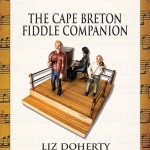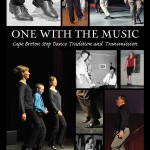Worth sharing: Fintan Vallely’s reflections on two CB books

 We recently had shared with us remarks by Fintan Vallely at the February 5 book launches—in Derry, Ireland—of Mats Melin’s One with the Music: Cape Breton Step Dance Tradition and Transmission and Liz Doherty’s The Cape Breton Fiddle Companion (both CBU Press 2015).
We recently had shared with us remarks by Fintan Vallely at the February 5 book launches—in Derry, Ireland—of Mats Melin’s One with the Music: Cape Breton Step Dance Tradition and Transmission and Liz Doherty’s The Cape Breton Fiddle Companion (both CBU Press 2015).
Fintan Vallely is a traditional irish flute and music educator, and author or editor of numerous books including The Companion to Irish Traditional Music. Fintan’s reflections are definitely worth sharing.
~~
Trains run to schedule, but buses are prone to unexpected delays, so much so that two might arrive together. Well, here we are with that syndrome in the music of Cape Breton, Nova Scotia: we arrive at 2016 with not one, but two major books on its music culture: Liz Doherty’s Cape Breton Fiddle Companion, and Mats Melin’s One with the Music: Cape Breton Step Dance Tradition and Transmission.
Why the two volumes come out so close together, and at this time, is of course that music, and writing about it, are more like the roads than railways, subject to interruption in the form of declines, revivals, unexpected turns and temporal hazards, and human decision-making. Both these books have had a lot of the unexpected to contend with, but their writers have somehow found and negotiated space amid high-pressure teaching of traditional music and dance, performance, travel, research and academic administration.
And so the two poles of Cape Breton island’s music are being launched here, representing the aesthetic and kinaesthetic, cultural and artistic, sociability and community. Both writings are – appropriately – published by Cape Breton University Press, but, it has to be said, perhaps most amazingly, both of them are compiled by scholars based in universities here on the island of Ireland where they are teachers in Traditional music studies. Liz Doherty is perhaps the longest-serving lecturer in this field in Ireland at this point, and was the youngest to gain such a role when she began third level teaching 22 years ago in 1994; she has now been nine years in University of Ulster. Mats Melin has taught for 21 years; he is from Sweden, but his interest in Scottish dance took him to Glasgow in 1995, and he has been in University of Limerick for eight years. There is something in this of course, because of the strength of the resurgence of Traditional music in Ireland – its track record for more than a century, peaking, somewhat surprisingly, in the Pop era after the 1950s. Indeed, we already have quite a stimulus to new writing in the form of the considerable body of academic and practical literature on Traditional music, all of which can be accessed on the shelves at the State-financed ITMA archive in Dublin. We have taught the music formally up to post graduate level too, most seriously since the 1980s.
Canada of course has done all of this as well (Liz’s book lists 440 publications) if perhaps not with quite the same cultural meaning or political impetus. But the music of Canada’s fiddlers has been part of the soundscape of that country’s social life and broadcasting for all of the 20th century, with many popular stars.
In that light, the compilation of these books by Limerick and Derry city lecturers and performers is a comment on the opportunities created by the mature out-looking of a confident – and State supported – Traditional music in both parts of Ireland rather than it being a failure of Cape Bretoners.
But even that does not strictly apply, for neither of these writers is quite an “outsider” at all. Liz and Mats have in fact utterly absorbed themselves in the aesthetic and social fabric of Cape Breton music-making and dance, making it their cultural homeland for a quarter of a century; in a way they are the inverse of (but no different to) the many Cape Breton music exiles who spent much of their working and music lives in cities in Canada or the United States.
These books are each a work of passion. They explore every nook and cranny in their observations, quotations and questions; each presents a quite amazing narrative e of a small island community of only c. 140,000 people which has evolved intricate music and dance forms and styles which are now core to Cape Breton’s identity and form a central plank of its tourism, a considerable economic boost to an economically-marginal region of Canada.
You read Mats and Liz as voices from within the music and dance communities, contemporaneous and historical at one and the same time. Their lists of performer biographies shows the particular relevance of music and dance to Cape Breton’s local communities – receding, as everywhere in the mid-20th century, but reviving with determined commitment after the 1970s. Indeed, as documented in the books, the symbiosis of dance and music on Cape Breton island itself has retained an efficacy long after it has slipped in the Scottish place of origin of Cape Breton’s music traditions. Particularly strong in this is the role of the piano: the appropriation of the supreme emblem of Western-music rationalisation by a music of the people, its many facets documented indeed in Liz’s book.
Mats Melin’s work is a tremendous window on every possible dimension of step dance and social dance: Transmission, teaching, meaning, aesthetics, tradition, dance structure, and biographies on key figures. Quotations from stylists reflect the breath, depth and time-span of his investigation; they are warm and powerful. Mats’s own observations are no less profound, notably his assessment of the aesthetic space dance represents for its performers: “a home from home where one can feel spiritually refreshed or feel rooted”.
He observes two styles of learning: the visual and the kinaesthetic, watching and feeling. In this regards he cites dance teacher Minnie Macmaster who would hold the hands of learners: “so they could feel the beat through my hands”. And Harvey Beaton, who considers that: “Dancing should be a personal language … subtlety, rather than fancy steps”.
Mats remarks on one dance class being held on a wooden bridge, so the dancers could feel the vibrations of their actions, and quotes anecdotes about dancers who, when travelling, might stop at a wooden bridge to have a bit of a dance, to feel the dance; He tells us too of lumbermen who when felling large trees would try out a dance on a freshly cut stump.
This draws in gender, change over time from this robust masculinity to the fact that dance in the home was in the past taught by the women, and in the 19th century classes were run by specialist male dance teachers, but now it is dominated by women.
Dance is not separated from music however, and their confluence and interconnectedness is noted in Mats’ observations on the vocabulary, dancers’ aesthetic keywords such as ‘timing’, which enabled: “ease of dancing and creating a lift that matches the swing of the music”. He notes too the overlap of the kinaesthetic and the aural – speaking of how the varying volume of stepped-out rhythms were a mnemonics patterning, remarking on the superiority of particular tunes for which a dancer would have a special “take”. His observations on changes since the 1970s are related to this – the disappearance of those very tune-specific dances, along with increasing complexity which is paralleled by weakening of aesthetic concepts.
Liz Doherty’s volume also summarises social dance practices in Cape Breton, but as an encyclopedia: with compact entries in a massive four hundred pages of data on fiddlers, fiddling style, tunes, fiddle history, revival, professionalism and change – a profound document with 900 individual topics.
The Fiddle Companion encompasses repertoire, aesthetic absorption, dedication, regional pride, professionalism, technology, and ongoing composition that bridges the music of this small place to mainstream Popular entertainment. There is much here for performers, lovers and students and teachers of any music form, since well ahead of the post-1977 fiddle-revival period there is a well-established professionalism shown among Cape Breton musicians, some of whom were nationally regarded in Canada. The exile community in the USA and Canadian cities are in themselves a tremendous story, and the legacy, influence – and often family trees – are traced through from vaudeville and 78rpm recording to modern-day world touring bands and digital transmission. We appreciate too from this book the importance of family reputation and influence, with documentary on families of musicians over several generations, many of them key players in modern time: there are some 900 indexed names, quite a statistic for a music from a population of 140K playing a derivative of Scottish Traditional music.
Yet this is not nostalgia, or a document of past glory, it is about a contemporary music form that is part of the modern-day commerce of professional music making as much as it is about cultural identity and preference: broadcasting, recording, migration and media are a binding medium in this text, rendering understandable the huge array of performers, their family histories, instrumental preferences, fiddle and piano technique and range of tune types, making the huge spectrum, technology and aesthetic preferences understandable, a comprehensive narrative that fills the mind with a sense of richness among economic poverty, worth in the hardship of Cape Breton as a developing region, and cultural and economic value on the music in today’s ruthless world. This book is nominally about Cape Breton, but like Mats Melin’s it is also fundamentally about the artistic integrity of a regional artform, the human need to connect with relevant music-scapes which have long historic roots, the psychological value of music in modernity.
Both these books are vital reading for the understanding of any regional Traditional music. They have much to say to Irish musicians in particular, because we in this country have also had a lengthy, extensive Traditional music revival that spans casual, functional dancing in kitchens to display on university platforms.
~~

